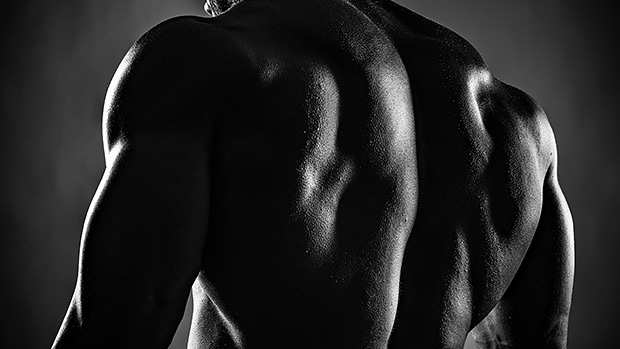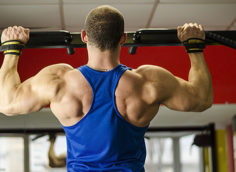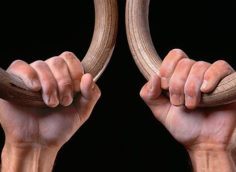Cancer and Quarantine
I love training and I usually never miss a workout. But in 2010 I was diagnosed with stage 2B Hodgkin's lymphoma: cancer. I was hospitalized for over two weeks. That's when they found two tumors in my chest.
One was the size of a lacrosse ball. It was above my right clavicle by my neck. The other one, tennis-ball sized, was located near my heart and pressed against my superior vena cava.
Before going to the hospital I was extremely tired and experiencing shortness of breath. I was only aware of the tumor above my clavicle because it had started as a mysterious bump a few months before. Eventually I was unable to even do an overhead press without getting dizzy. It grew so much that lifting my arm up was no longer an option. Walking a block was exhausting.
After being released from the hospital I was treated with chemotherapy. Because of the chemo and a lack of insurance to get adequate medication, my immune system plummeted and my white blood cell count was very low.
My oncologist had forbidden me from leaving the house. He also said I wouldn't be allowed to work or go to the gym due to my compromised immune system. I was only permitted to walk around the house and maybe stretch for exercise. I did just that for one month.
Then, by the end of my fourth week of treatment, the tumor at my neck shrank almost completely and I could breathe better! That meant I could raise my arm again. And so the workout junkie in me said, "Yes, I'm going to go back to working out."
However, I still couldn't leave the house since my immune system couldn't even fight a common cold. I needed to exercise at home using only my bodyweight. And so I did.
For a little over seven months I was quarantined. I did six months of chemotherapy followed by one month of radiation. Coming out of the hospital I weighed 144 pounds. I was unable to lift a glass of water and my grandmother had to help me walk.
By the time I reached my last dosage of chemo I was 180 pounds with visible abs. I was doing one-arm push-ups and one-legged jump squats. Yes, it was hard and challenging. Yes, I missed my friends and family.
And on top of being isolated from the world, I had to deal with the mental and physical hurdles of cancer and chemo/radiation treatment. But working out was my saving grace.
It's intellectually stimulating to refine exercises and come up with new strategies. You become a MacGyver of sorts and use what you have on hand. Every day I looked forward to trying to beat my previous performance, either by reps or a new challenging exercise.
Physically, mentally, and spiritually, I came out of my cancer treatment and quarantine as an entirely different person than when I went in. And so can you.
One problem with bodyweight training is that it always has holes. If you look at most bodyweight enthusiasts, they often have very developed chests, lats, and arms (from pull-ups and push-ups) but are often lacking delts, hamstrings, and the "pillars" you see on most serious lifters which make up their spinal erectors. They lack true posterior strength and the ability to develop strong and broad shoulders.
Regardless of why you're needing to skip the gym, here are some exercises that'll fill those holes and allow you to build both strength and size.
Push Back
Handstand push-ups are great and all, but your range of motion is limited by your head coming into contact with the floor. The push back allows you to have a full range of motion and is similar to the barbell overhead press.
- Grab the edge of a bench, step, or chair and bring your feet out to assume the downward dog position.
- Get your feet far and wide enough apart that your lower back doesn't round.
- Keep your fingers wide and "grip" the surface.
- Keeping your force on the heel of your palm, slowly bring yourself to the edge until your collar bone lightly touches it.
- Forcefully push back to the starting position. It's crucial to keep your forearms parallel to your torso, otherwise it will greatly involve the chest... turning it into a push-up.
Stiff-Legged Step-Up
- Have the foot of the working leg extended forward onto the step with only your heel on the surface.
- Make sure your hips are perpendicular to the working leg.
- Get your opposite, or non-working leg, in the "dead" step-up position. This means toes pointed up and knees locked out, which will negate the help you get from pushing off the other leg. Your non-working leg's heel should be the only thing touching the ground.
- Bend at the waist as much as you can without losing the natural arch of your lower back. The more flexibility you have in the hamstrings, the greater the stretch and range of motion you'll have. Think of how full-range squats are more beneficial than partial squats.
- Retract your scapula and squeeze them together tightly. Your posterior neck muscles should be contracted to maintain proper cervical spine position.
- Contract the glutes and hamstrings of the working leg to bring yourself up towards the step and achieve full hip extension by locking out the glutes.
- Keeping the knee of your working leg stiff (or straight as possible without locking out the knees), return to the start position.
- Remember to lean a bit forward to increase the range of motion on the eccentric or negative. This will also help prepare you for the next rep and create more continuous tension on the working muscles.
Door Row
Not everyone has access to a bar to do inverted rows, but most of us have access to a door! Just use the open (lock side) of the doorframe.
- Stand in front of the adjacent wall and line up your shoulder to the frame. You'll be facing directly at the wall.
- Grab the frame at about rib height with an open-handed, tight, thumbless grip. Keeping your body facing parallel to the wall, lean back until your arm and shoulder blades are completely extended.
- Focus on your back muscles, retract your shoulder blades, squeeze the lats, and pull yourself back to the starting position. You want this to feel like a dumbbell row or machine row.
- To emphasize the lats even more, focus much of your pressure on pulling through the pinky. Keeping your elbows close to the body will also maximize lat tension.
We can make the exercise harder with the door "high row" variation which allows for a greater range of motion. The starting position is the same as the regular door row. This time, as you move back, you're squatting down to the point where your extended arm's hand is in line with your head. You pull up in the same fashion as the regular door row until you're back at the start position.
Note: You don't want to support yourself with your legs. The full tension should be on your working arm and lat. The high row should feel like you're using a high-row machine or doing a Pendlay row.
Reverse Hyperextension
This will require you to have access to anything that allows you to rest your body prone on the surface while your legs hang downward at 90 degrees. A bed usually works. Next would be any bench or table strong enough to counterbalance your weight at the end of it, such as a park bench or table that's secured to the ground.
- Position yourself on the short/bottom side of the bed. If you're forced to use the long side of the bed, an effective method is placing a strong blanket underneath the mattress and over the top. With it positioned as such, your own weight will anchor it down giving you support to hang off.
- If using a table or bench you can extend your arms out to the side and grab the edges to hold onto for support. If your feet are too long to fully extend, just bend them as much as needed to get to the bottom position.
- Try to hook at least one arm under the mattress with the other arm extended out to the side for better grip and balance.
- Extend your knees as you raise up. I like to add a pillow or two underneath my waist to give myself more height. A pillow has the added benefit of giving you the option of rounding your back for greater range of motion.
Wall Lateral "Raise"
Using just a wall you can work the medial and rear delts.
- Bring your feet about a foot away from the wall.
- Lean on the wall with the side of your body, resting your humerus on it, and keep your elbow at a 90-degree angle pointed to the ground.
- Depress your shoulder blades to avoid overcompensating with the traps.
- Push yourself through the elbow and contract your delts. Your waist will lean slightly but that's fine since at this point you'll have a peak contraction on the delts.
To emphasize your rear delts, assume the same position as before, then...
- Bring your arm upward to parallel with the floor and keep your elbow bent.
- Push yourself up through the elbow using the rear delts.
- Don't overcompensate with the traps. Your body will turn slightly, but keep going to get a peak contraction.
- To increase the intensity, reduce the bend of your elbow making your arm arc as though it were hugging a large barrel. This time you'll push through the elbow, but keep going until the force rolls on through the forearms and ultimately stops by the wrist.
Elevated Plank
You can increase the intensity of your basic plank by simply raising your feet onto a higher surface. The higher you go, the more the transverse abdominis has to work.





